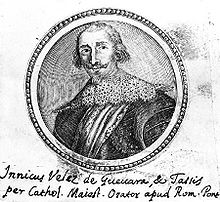Íñigo Vélez de Guevara, Conde de Oñate
Don Íñigo III. Vélez de Guevara y Tassis , seventh Count of Oñate and Count of Villamediana (* 1566 - October 31, 1644 in Madrid ) was a Spanish statesman and diplomat.
Life
Íñigo Vélez was a son of Pedro Vélez de Guevara, Lord of Salinillas , and María de Tassis and thus a grandson of the Spanish Postmaster General Raimundo de Tassis (Raimund von Taxis) (around 1515–1579). By marrying his blood relative Catalina Vélez, daughter of Count Pedro Vélez de Guevara, he gained County Oñate, as the only brother of his wife, Count Ladrón Vélez de Guevara, in the battle of the Spanish Armada against the English fleet in the Strait of Dover had perished in 1588. After the Spanish postmaster general Don Juan de Tassis, Count of Villamediana, Íñigo's cousin, was murdered in Madrid in 1622, he was also the next heir to his finished county and should also bear the name and coat of arms of the Tassis.
Íñigo Vélez de Guevara was - even before his accession to the throne - Lord Chamberlain of King Philip III. of Spain and served him in the Dutch Wars, where he was also captured. He then became a Knight of the Order of St. Jacob . He served his king in various diplomatic missions, at the court of Duke Karl Emmanuel of Savoy , in Hungary and finally at the court of Emperor Matthias in Vienna , whom he helped to secure the Austrian succession and the successor to Archduke Ferdinand of Inner Austria as Ferdinand II . The Oñate Treaty was named after him.
He remained as a Spanish special envoy during the reign of Ferdinand II at the Viennese court, where he belonged to the party of opponents of Wallenstein , to whose fall he contributed significantly.
Vélez was so favored at the Spanish court that he was supposed to succeed the Duke of Alba as Chief Chamberlain of Philip IV , although the king's favorite, Prime Minister Gaspar de Guzmán , conde-duque de Olivares, was his avowed enemy. After his fall, his position improved so much that he was even under discussion as his successor. But since he made too high demands for himself and his sons, he incurred the displeasure of the king and so Don Luís de Haro became Minister of State instead . When Philip went on a trip to Aragón in 1643 , he left Vélez in Madrid with Queen Isabella and advised her to listen to his advice.
Don Íñigo Vélez de Guevara died as a royal secretary and state councilor and president of the council of royal orders in Madrid in 1644 . His son, Don Íñigo IV, wanted to have his body buried with great splendor in the Church of San Felipe in Madrid. But since the king interpreted this as an inappropriate coincidence with the funeral of his first wife, Queen Isabella , who had also recently died (October 6, 1644), the mourning decorations had to be removed and Don Íñigo received a fine of 4,000 reales .
progeny
From her marriage to Doña Catalina Vélez de Guevara there were nine children:
- Pedro, was killed in a fall from a horse in Milan
- Iñigo IV. (1597–1658), Viceroy of Naples from 1648 to 1653 ( Virrey de Nápoles )
- Juan, entered the clergy
- Felipe Emmanuel, royal Spanish colonel, fell near Perpignan in 1642
- Beltrano, Marques de Montereale , Viceroy of Sardinia
- María Ana, married Don Antonio María († 1678), 3 ° Principe di Musocco, since 1656 1 ° Marchese di Melzo
- Maria Angela, nun
- Catalina, religious
- Ana Maria, nun
| personal data | |
|---|---|
| SURNAME | Velez de Guevara, Íñigo, Conde de Oñate |
| ALTERNATIVE NAMES | Vélez de Guevara y Tassis, Íñigo III. |
| BRIEF DESCRIPTION | Spanish statesman and diplomat |
| DATE OF BIRTH | 1566 |
| DATE OF DEATH | October 31, 1644 |
| Place of death | Madrid |
